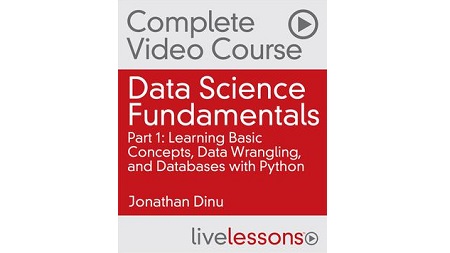
English | MP4 | AVC 1280×720 | AAC 44KHz 2ch | 20h 54m | 5.69 GB
Data Science Fundamentals LiveLessons teaches you the foundational concepts, theory, and techniques you need to know to become an effective data scientist. The videos present you with applied, example-driven lessons in Python and its associated ecosystem of libraries, where you get your hands dirty with real datasets and see real results.
If nothing else, by the end of this video course you will have analyzed a number of datasets from the wild, built a handful of applications, and applied machine learning algorithms in meaningful ways to get real results. And along the way you learn the best practices and computational techniques used by a professional data scientist. More specifically, you learn how to acquire data that is openly accessible on the Internet by working with APIs. You learn how to parse XML and JSON data to load it into a relational database.
What You Will Learn
- How to get up and running with a Python data science environment
- The essentials of Python 3, including object-oriented programming
- The basics of the data science process and what each step entails
- How to build a simple (yet powerful) recommendation engine for Airbnb listings
- Where to find quality data sources and how to work with APIs programmatically
- Strategies for parsing JSON and XML into a structured form
- The basics of relational databases and how to use an ORM to interface with them in Python
- Best practices of data validation, including common data quality checks
Who Should Take This Course
- Aspiring data scientists looking to break into the field and learn the essentials necessary
- Journalists, consultants, analysts, or anyone else who works with data and looking to take a programmatic approach to exploring data and conducting analyses
- Quantitative researchers interested in applying theory to real projects and taking a computational approach to modeling.
- Software engineers interested in building intelligent applications driven by machine learning
- Practicing data scientists already familiar with another programming environment looking to learn how to do data science with Python
Table of Contents
1 Data Science Fundamentals Part 1 – Introduction
2 Topics
3 1.1 Welcome to the Course
4 1.2 Why Data Science and Why Now
5 1.3 The Potential of Data Science
6 1.4 Getting Set Up with a Data Science Development Environment
7 1.5 A Python (3) Primer
8 1.6 Python 2 versus Python 3
9 1.7 Test Your Knowledge – Wordbuzz
10 1.8 Wordbuzz – Putting it all Together
11 1.9 Python Review and Resources
12 1.10 Python for Data Science
13 1.11 What’s to Come
14 Topics
15 2.1 Introduction to the Data Science Process
16 2.2 Defining Your Problem
17 2.3 Acquiring Data
18 2.4 Wrangling Data
19 2.5 Exploring Data
20 2.6 Recommendations through Triangle Closing
21 2.7 Python Development Workflow
22 2.8 Triadic Closure in Python
23 2.9 Challenges of Recommendation Systems
24 2.10 Obtaining an Evaluation Baseline
25 2.11 Inspecting and Evaluating Results
26 2.12 Present and Disseminate
27 2.13 The Data Science Process Applied—Cheaper Beds, Better Breakfasts
28 Topics
29 3.1 The Data Science Mindset
30 3.2 The Data Science Technology Stack
31 3.3 Where to Get Data – Sources and Services
32 3.4 How the Web Works
33 3.5 Making HTTP Requests with Python
34 3.6 Adding Context with Open Data
35 3.7 Parsing Data with Python—JSON and XML
36 3.8 Data and File Formats
37 3.9 Working with APIs
38 3.10 Parametric API Requests with Python
39 3.11 Exploring the Foursquare API
40 3.12 Downloading Foursquare Venues
41 Topics
42 4.1 Introduction to the ETL Pipeline
43 4.2 Data Models—Adding Structure to Data
44 4.3 Building Abstractions—Object Oriented Programming
45 4.4 Creating Classes in Python
46 4.5 Defining Methods and Updating State
47 4.6 Magic Methods, Class Attributes, and Introspection
48 4.7 Exploring and Structuring the Foursquare Response
49 4.8 Data Models Applied—Representing Foursquare Entities with Classes
50 4.9 Modeling Behavior with Methods
51 4.10 Customizing Model Interfaces with Setter Methods and Virtual Attributes
52 4.11 Keeping Things DRY with Inheritance
53 4.12 Object-Oriented Programming Use Cases
54 4.13 The Case for (and against) OOP
55 Topics
56 5.1 Introduction to Databases with SQLite
57 5.2 Inspecting Databases with the SQLite shell
58 5.3 The Database Landscape
59 5.4 What’s in a Schema Mapping Data Models to Data Tables
60 5.5 Introduction to Object Relational Mappers
61 5.6 ORMs in Python with peewee
62 5.7 Creating and Querying Records with peewee
63 5.8 End-to-end ETL in Python
64 5.9 Advantages and Disadvantages of ORMs
65 5.10 Extract, Transform, Load—Putting It All Together
66 Topics
67 6.1 Introduction to Exploratory Data Analysis
68 6.2 Understanding your Data Quickly with Graphical Tools
69 6.3 Inspecting Databases and Building Schemas with peewee
70 6.4 Data Quality Checks with peewee
71 6.5 Finding Missing Data and Null Values with peewee
72 6.6 Dealing with Missing Data
73 6.7 EDA for Insight—Describing Data
74 6.8 Inspecting Queries and Displaying Results in peewee
75 6.9 Groups and Aggregates with peewee
76 6.10 Ranking and Sorting Venues
77 6.11 SQL Relations and Joins
78 6.12 Joins with peewee
79 6.13 Querying Across Datasets with Joins
80 6.14 Translating peewee to SQL
81 6.15 A Visual Introduction to Joins with SQL
82 Data Science Fundamentals Part 1 – Sunmary
Resolve the captcha to access the links!